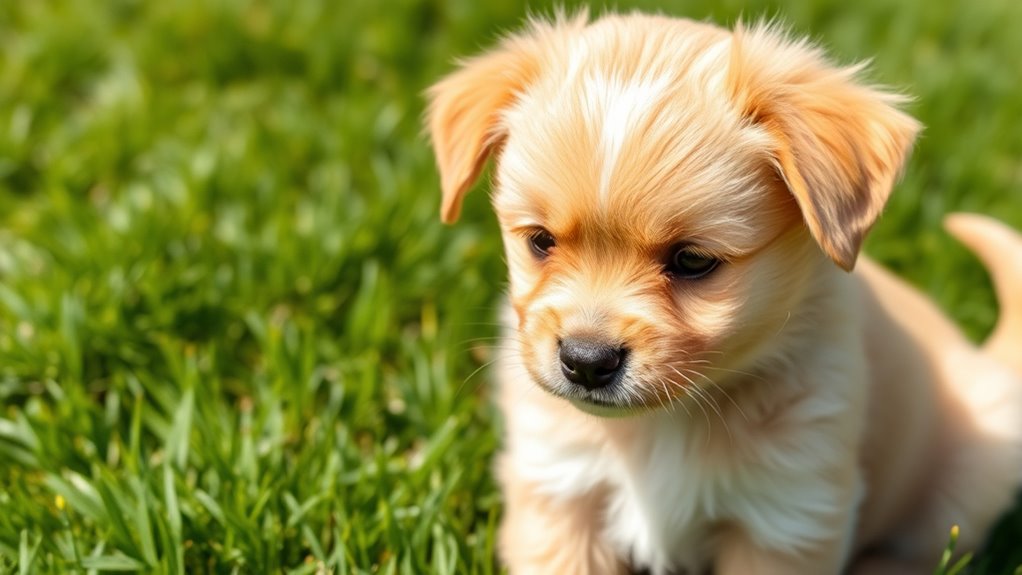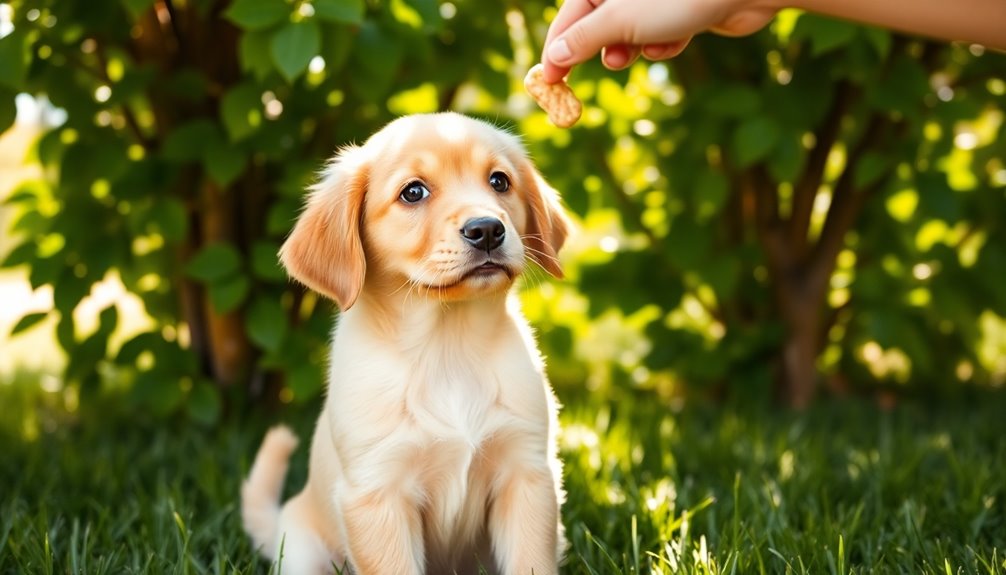To understand your puppy’s body language, watch for signs of happiness like wagging tails, relaxed bodies, and playful gestures such as bouncing or gentle biting. Look out for stress cues like tucked tails, flattened ears, avoiding eye contact, or tense muscles. Recognizing these signals helps you respond appropriately and build trust. If you pay close attention to your puppy’s overall posture and subtle cues, you’ll gain better insight into how they’re feeling and how to support their emotional well-being.
Key Takeaways
- Wagging tails can indicate happiness or nervousness; observe overall body language for accurate interpretation.
- Playful gestures like bows and bouncing signal excitement and willingness to engage.
- Signs of stress include cowering, tucked tail, flattened ears, and avoidance behaviors.
- Relaxed bodies, bright eyes, and wagging tails typically show happiness and comfort.
- Recognizing subtle cues like lip licking and yawning helps gauge your puppy’s emotional state.

Puppies communicate their feelings and needs primarily through their body language, making it essential for you to learn how to interpret these signals. Recognizing the difference between playful gestures and fearful cues helps you understand whether your puppy is happy, excited, or anxious. Playful gestures, like wagging tails, bowing, or bouncing around, usually indicate that your puppy is feeling joyful and eager to interact. When your puppy playfully bows, with front legs stretched forward and rear end up, it’s a clear sign they want to engage in fun activities. A wagging tail, especially when combined with relaxed body posture, often signals friendliness and happiness. Playful biting or gentle nipping can also be part of their joyful interactions, showing they’re comfortable and want to invite you to play.
Conversely, fearful cues are subtle but important signals of stress or discomfort. Your puppy might cower, tuck their tail tightly between their legs, or flatten their ears against their head when they feel overwhelmed. A fearful puppy may also avoid eye contact, shrink away from your touch, or exhibit lip licking or yawning when they’re anxious. These cues are their way of communicating that they’re feeling insecure or threatened, and it’s vital to respect these signals to prevent escalation. For example, if your puppy backs away when you approach, they might be scared or unsure, and forcing contact could increase their stress. Recognizing these cues early allows you to give your puppy space and reassurance, helping them feel safe. Additionally, understanding body language cues can improve your overall communication and strengthen your bond with your puppy. Recognizing your puppy’s body language involves paying close attention to the overall context as well. A wagging tail doesn’t always mean happiness—sometimes, it can be a sign of nervous excitement. Similarly, a stiff body or raised hackles often signals alertness or defensiveness, not playfulness. When your puppy exhibits playful gestures, they tend to have a relaxed, loose body, bright eyes, and a wagging tail, all indicating positive emotions. Conversely, fearful cues often involve tense muscles, lowered body posture, or a tucked tail, showing discomfort.
Frequently Asked Questions
How Can I Tell if My Puppy Is Nervous or Just Playful?
You can tell if your puppy is nervous or just playful by observing their body language. Playful puppies often wag their tails, have relaxed body movements, and may vocalize excitedly. Nervous puppies might display tense muscles, tucked tails, and hesitant vocalizations. Watch for subtle cues like tail positioning—high and wagging indicates happiness, while tucked tails suggest discomfort. Pay attention to their overall demeanor to understand their true feelings.
What Are Subtle Signs of Stress in Puppies?
You can spot subtle signs of stress in your puppy through calming signals like yawning, lip licking, or avoiding eye contact. These signs help differentiate stress from excitement. When your puppy displays these signals, it’s a cue to give them space and reassurance. Recognizing these calming signals early helps you respond appropriately, reducing their stress and ensuring they feel safe during new or overwhelming situations.
How Do Body Language Cues Differ Among Breeds?
Ever wonder why your puppy’s body language varies? Breed-specific gestures influence how they express stress or happiness, with some breeds more vocal or energetic, while others are subtle. Crossbreed differences mean you should observe individual cues closely, as each dog’s signals might differ even within the same breed. Recognizing these nuances helps you better understand your pup’s feelings and respond appropriately, strengthening your bond and ensuring their well-being.
Can Puppies Hide Stress Behind Happy Gestures?
Yes, puppies can hide stress behind happy gestures. You might notice a puppy’s facial expressions and tail wagging nuances that seem cheerful, but their body language could reveal tension, like stiff posture or tucked tail. Pay close attention to subtle cues, such as a quick tail wag or forced smile, which might mask discomfort. Recognizing these signs helps you better understand when your puppy’s truly happy or feeling stressed.
What Should I Do if I Notice Signs of Anxiety?
When you notice signs of anxiety in your puppy, act quickly like a gentle lighthouse guiding a ship. Use relaxation techniques such as soothing voice and gentle petting to comfort them. Make environmental adjustments by creating a calm, safe space free from loud noises or overstimulation. These steps help your pup feel secure and relaxed, turning their worry into a wave of calm and trust.
Conclusion
By paying close attention to your puppy’s body language, you’ll open a world of understanding that deepens your bond. But remember, puppies can hide their true feelings just as easily as they reveal them. Are you ready to spot the subtle signs that tell you when your pup’s truly happy or feeling stressed? Stay observant, trust your instincts, and you’ll soon uncover the secrets behind their adorable expressions—your journey into their world has only just begun.










